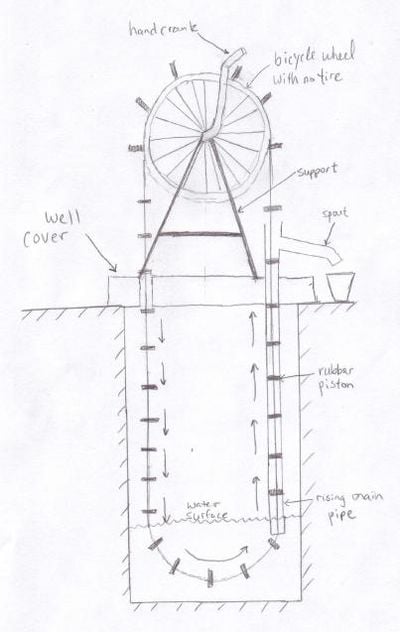| Line 29: | Line 29: | ||
=='''Engineering Calculations and Principles'''== | =='''Engineering Calculations and Principles'''== | ||
'''Step 1''': Cut a hole in the box | |||
=='''Required Materials and Tools'''== | =='''Required Materials and Tools'''== | ||
Revision as of 18:37, 5 April 2010
Abstract
Background
| A basic rope pump schematic |
|---|

|
Figure 1
History
Rope pumps were first developed as a relatively inexpensive solution for drawing water out of wells up to 50 metres deep. Within the 1970's and 80's, specifically in Nicaragua, many different rope pump designs began to emerge - specifically the one shown in figure 1 above. Once the foundation for this technology was discovered, the 1980's proved to be a major optimization period for the new technology. Quite possibly, the most significant development in the 80's was the ability to inject plastics into moldings, leading to the use of inexpensive PVC pipes. Not only being inexpensive, the durable, long lasting and rust-preventative nature of polyvinyl-chloride has led to its continual use in rope pumps in this present day.
The Standard Rope Pump
Figure 1 shows a simple diagram of how the standard rope pump developed in the 1980's works. Above the hand-dug well is a bicycle wheel without its tire, which is able to freely rotate about its axis. Connected via chain to the bicycle wheel is another pinion, which contains the pedals (or hand crank) used to turn the wheel. Different sizes of pinions can be used to further limit the load needed, however, with a reduction of load comes a reduction of speed and thus mass flow rate. A rope runs along the edge of the bicycle wheel and dips freely into the well, finally running up a fixed PVC pipe (which runs down just below the surface of the water) and back to the bicycle wheel. Attached to this rope at fixed distances apart are "pistons" which have are just smaller than the PVC pipe diameter. Figure 2 illustrates these pistons.
Engineering Calculations and Principles
Step 1: Cut a hole in the box